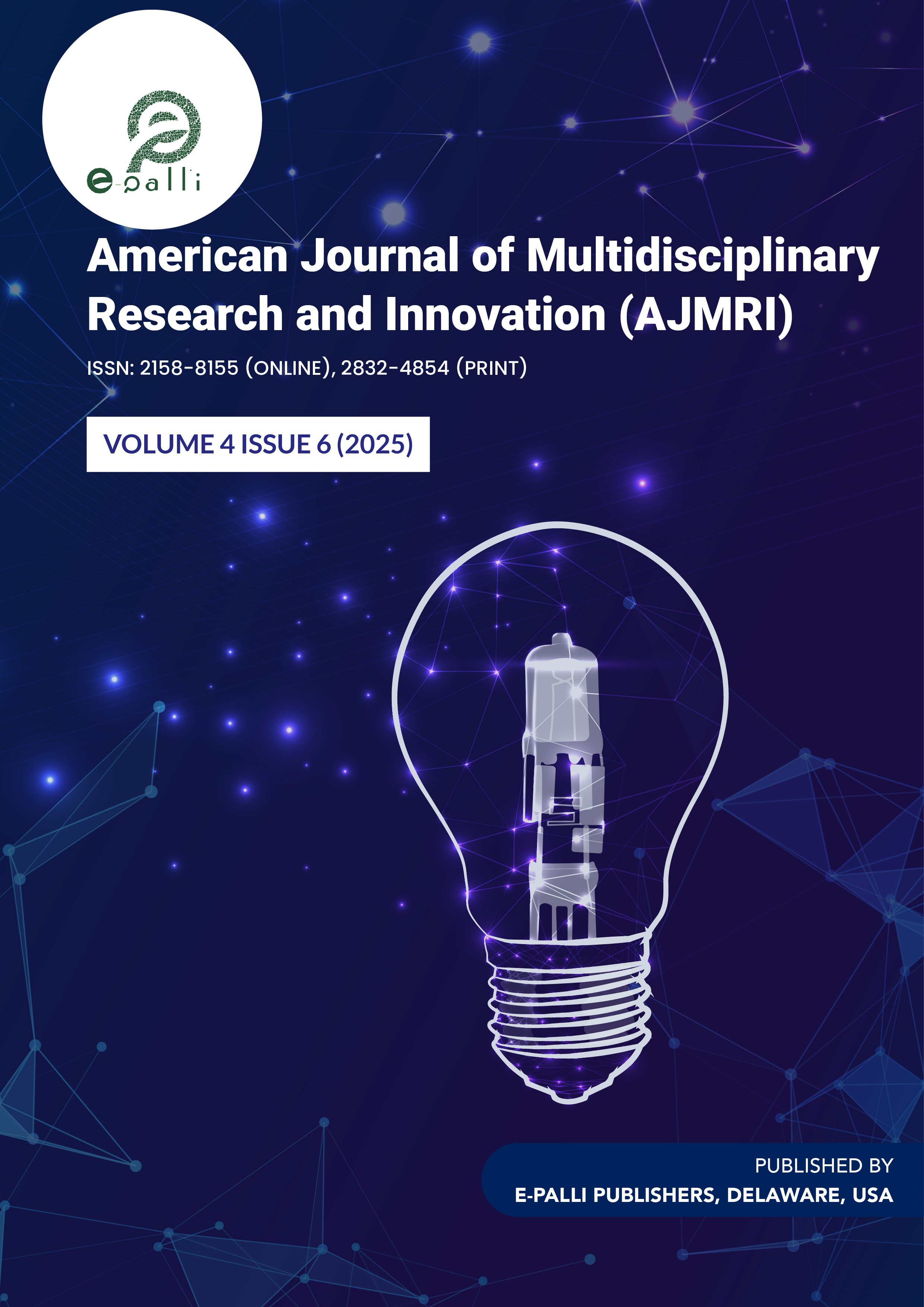Unlocking the Black Box of Financial Innovation: A Case Study of Banking Institutions in the Eastern Region of Ghana
DOI:
https://doi.org/10.54536/ajmri.v4i6.6067Keywords:
Brainstorming, Innovation, Policymakers, Stakeholder-Engagement, UnlockingAbstract
Ghanaian business owners and clients are of the view that the use of innovation, especially technology could influence the growth of financial institutions in Ghana, and one of the key focus of the study has been how the use of innovation could serve as a means to ensure business sustainability. Interestingly, most qualitative respondents concurred the use of innovation as a means to ensure business sustainability. The study, “Unlocking the Black Box of Financial Innovation: A Case Study of Banking Institutions in the Eastern Region of Ghana” could help identify action plans through existing frameworks to optimize performance among financial institutions in the Eastern Region of Ghana. The study is based on secondary data sources with qualitative research, observing and describing events as they occur, with the goal of capturing all of the richness of everyday behavior. The intricacies of financial innovation remain shrouded in mystery, with limited understanding of its drivers, mechanisms, and risk management strategies, a knowledge gap that hinders policymakers, regulators, and industry stakeholders from optimizing financial innovation’s potentials. The study establishes the following key findings: 1). Majority of customers and clients of financial services are of the view that technology influences the growth of institutions in Ghana. 2). Innovativeness has led to improvement of the financial services and improved payment systems 3). The fear of unknown and lack of awareness creation are the key triggers of resistance to innovativeness in organization. The study provided the following as key recommendations: Business leaders should see innovation as the key element to reach customer satisfaction, Organizations should focus on products, types of product, stages and features and also pay more attention on the role it plays in realizing competitive advantage, Banking institutions should consider speed and simplicity as their priorities, leading to the focus on clients in their operations to ensure they are maintained, Financial institutions should have policies that seek to reward Innovation ideas at every leve to encourage employees to come up with new ideas all the time, Business leaders should forge strategies including stakeholder-engagement, brainstorming and awareness creation, and idea cascaded down to get others behind a change. The study argues that within the context of the rapidly changing operating environment, simplification, stringent risk management, and innovative mindset should be considered as tools for adaptive capabilities.
Downloads
References
Abor, J. (2004). Technological innovations and banking in Ghana: An evaluation of customers’ perceptions. African Journal Online. http://www.ajol.info/index.php/ifep/cart/view/23668/20166
Anderson, N., De Dreu, C. K. W., & Nijstad, B. A. (2014). Innovation and creativity in organizations: A meta-analysis of organizational, group, and individual factors. Journal of Applied Psychology, 99(3), 587–616.
Arnoni, R., et al. (2016). Future of payments in Australia: The future of transaction banking and payments in 2020.
Bech, M., & Hancock, J. (2020). Innovation in payments. BIS Quarterly Review. https://www.bis.org/publ/qtrpdf/r_qt2003f.htm
Bozhinova, M., & Georgieva, K. (2019). Organizations for tourism region management in Bulgaria–trends and challenges. Trakia Journal of Sciences, 17(1), 365-370. https://doi.org/10.15547/tjs.2019.s.01.060
Brigham, E. F. (1992). Fundamentals of financial management (6th ed.). The Dryden Press. https://www.academia.edu/40918315/Fundamentals_of_Financial_Management_Eleventh_Edition
Cenamor, J., Sjödin, D., & Parida, V. (2017). Adopting a platform approach in servitization: Leveraging the value of digitalization. International Journal of Production Economics, 192, 54–65.
Domeher, D., Frimpong, J. M., & Appiah, T. (2014). Adoption of financial innovation in the Ghanaian banking industry. African Review of Economics and Finance, 6(2), 88–114. https://www.african-review.com/journal/v6(2)december2014/Financial%20innovation%20in%20Ghana.pdf
Dweck, C. S. (2006). Mindset: The new psychology of success. Random House.
Frimpong, J. M. (2010). Exchange rate pass-through in Ghana. International Business Research, 3(2), 134–141. file:///C:/Users/ex0218pkc/Downloads/4662-17626-1-PB%20(1).pdf
Lin, C., Ma, Y., & Xue, M. (2018). Banking and innovation: A review. ADBI Working Paper 815. Asian Development Bank Institute. https://www.adb.org/publications/banking-and-innovation-review
McGourty, J., Tarshis, L. A., & Dominick, P. (1996). Managing innovation: Lessons from world-class organizations. International Journal of Technology Management, 11(3–4), 354–368.
Mihić, M., Ostojić, A., Umihanić, B., & Fazlović, S. (2015). The role of organizational innovation in achieving and maintaining company’s business excellence. Economic Review, 20(1), 79–100.
Nguena, C. L. (2015). Boosting investment and business environment in Africa today: Mobile banking as an optimal strategy for financial inclusion. http://nguena.blogspot.com
Nguena, C. L. (2019). Financial innovation in developing countries: The determinants of mobile banking in Africa. Economic Literature. https://ideas.repec.org/a/cai/jiedbu/jie_029_0069.html
Nguena, C. L. (2019). Mobile financial and banking services development in Africa. Working paper for the African Development Bank Group. https://www.afdb.org/en/documents/publications/working-paper-series
No condition is permanent: Middle class in Nigeria in the last decade. (2015). World Bank Policy Research Working Paper 7214. https://openknowledge.worldbank.org/bitstream/handle/10986/21653/WPS7214.pdf?sequence=1&isAllowed=y
Oke, A. (2002). Making it happen: How to improve innovative capability in a service company. Journal of Change Management, 2(3), 272–281.
Pavón, J. A. T. (2009). Entrepreneurship and the business plan. https://www.diva-portal.org/smash/get/diva2:228358/fulltext01.pdf
Petralia, K., Philippon, T., Rice, T., & Veron, N. (2019). Banking disrupted? Financial intermediation in an era of transformational technology. Geneva Report on the World Economy. https://cepr.org/system/files/publication-files/60127-geneva_22_banking_disrupted_financial_intermediation_in_an_era_of_transformational_technology.pdf
Reguia, C. (2014). Product innovation and the competitive advantage. European Scientific Journal, Special Edition, 1, 1–10. https://core.ac.uk/download/pdf/328024363.pdf
Smollan, R. (2011). The multi-dimensional nature of change. Faculty of Business and Law, Auckland University of Technology, 17, 1–20. https://www.researchgate.net/profile/Roy-Smollan/publication/271151111_The_multi-dimensional_nature_of_resistance_to_change/links/55cbac3408aeb975674c80f2/The-multi-dimensional-nature-of-resistance-to-change.pdf
Zhang, X., Li, Y., & Wang, J. (2023). Digital finance and financial literacy: Evidence from Chinese households. Journal of Banking & Finance, 156, 107005.
Downloads
Published
Issue
Section
License
Copyright (c) 2025 Doreen Adu, Francis Sarkodie-Addo

This work is licensed under a Creative Commons Attribution 4.0 International License.







